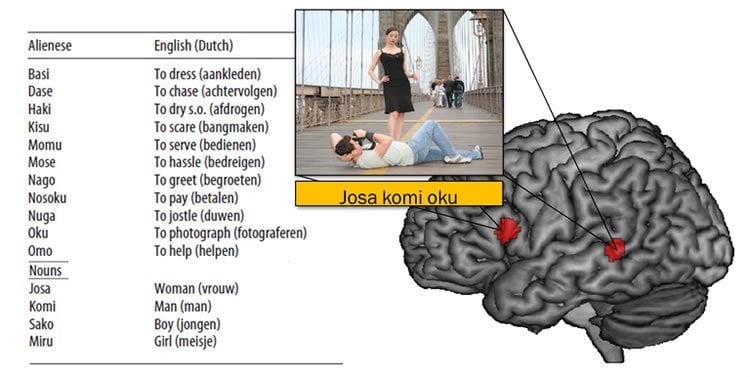Summary: A new study shows how new linguistic information is integrated into the same brain areas used for your native language.
Source: Max Planck Institute.
Our brain benefits from an overlap in grammar when learning a foreign language.
Researchers from Nijmegen have for the first time captured images of the brain during the initial hours and days of learning a new language. They use an artificial language with real structures to show how new linguistic information is integrated into the same brain areas used for your native language.
Learning a new language is a difficult task. It requires skills for memorizing new words, learning how to put those words together in a grammatical way, and integrating them with existing linguistic knowledge. In a new study from researchers at the Donders Institute and Max Planck Institute for Psycholinguistics, these skills were observed through brain imaging as native speakers of Dutch learned an artificial miniature language ‘Alienese’.
Reuse grammatical characteristics
The major discovery was that the brain cares whether or not the grammatical properties of the new language (in this case, word order) resemble the grammatical properties of your native language. If they are similar, your brain uses its own grammar in learning the new language. And if the word order of the new language differs from your mother tongue, your brain needs to build a new grammatical repertoire. For the first time, researchers have shown that it helps the brain if it can reuse characteristics of our mother tongue when learning a new language.
Josa komi oku
Alienese consisted of a set of words like josa ‘woman’, komi ‘man’, and oku ‘to photograph’. These words could be combined in a particular order, which either did or did not conform for Dutch word order. For instance, both sentences Komi oku josa (man photograph woman) and Josa komi oku (woman man photograph) have the meaning “The man photographs the woman”. The former sentence conforms to Dutch word order (and English), but the latter does not. Participants read sentences with familiar and unfamiliar word orders accompanied by pictures depicting the meaning.

Language brain network
When the unfamiliar word orders (josa komi oku) were repeated, brain activation increased within regions of the brain network known to be involved for your native language. Lead author of the study Kirsten Weber proposes, “The enhanced activity might reflect a brain mechanism to build and strengthen a neural network to process novel word order regularities.” When the familiar word order (komi oku josa) was repeated, brain activation decreased in language-related regions. “That we found suppressed activation on the other hand, supports our ideas that a known structure in a novel language quickly behaves like a structure in your native language. Processing a known structure is easier for the brain second time round. As a whole, our study shows that we seem to use the same brain areas for native and new language structures and that Alienese was in the process of being integrated into the participants existing language brain networks.”
Source: Charlotte Horn – Max Planck Institute
Image Source: This NeuroscienceNews.com image is adapted from the MPI press release.
Original Research: Abstract for “fMRI Syntactic and Lexical Repetition Effects Reveal the Initial Stages of Learning a New Language” by Kirsten Weber, Morten H. Christiansen, Karl Magnus Petersson, Peter Indefrey, and Peter Hagoort in Journal of Neuroscience. Published online June 29 2016 doi:10.1523/JNEUROSCI.3180-15.2016
[cbtabs][cbtab title=”MLA”]Max Planck Institute. “Watching the Brain During Language Learning.” NeuroscienceNews. NeuroscienceNews, 29 June 2016.
<https://neurosciencenews.com/neuroimaging-language-learning-4603/>.[/cbtab][cbtab title=”APA”]Max Planck Institute. (2016, June 29). Watching the Brain During Language Learning. NeuroscienceNew. Retrieved June 29, 2016 from https://neurosciencenews.com/neuroimaging-language-learning-4603/[/cbtab][cbtab title=”Chicago”]Max Planck Institute. “Watching the Brain During Language Learning.” https://neurosciencenews.com/neuroimaging-language-learning-4603/ (accessed June 29, 2016).[/cbtab][/cbtabs]
Abstract
fMRI Syntactic and Lexical Repetition Effects Reveal the Initial Stages of Learning a New Language
When learning a new language, we build brain networks to process and represent the acquired words and syntax and integrate these with existing language representations. It is an open question whether the same or different neural mechanisms are involved in learning and processing a novel language compared with the native language(s). Here we investigated the neural repetition effects of repeating known and novel word orders while human subjects were in the early stages of learning a new language. Combining a miniature language with a syntactic priming paradigm, we examined the neural correlates of language learning on-line using functional magnetic resonance imaging. In left inferior frontal gyrus and posterior temporal cortex, the repetition of novel syntactic structures led to repetition enhancement, whereas repetition of known structures resulted in repetition suppression. Additional verb repetition led to an increase in the syntactic repetition enhancement effect in language-related brain regions. Similarly, the repetition of verbs led to repetition enhancement effects in areas related to lexical and semantic processing, an effect that continued to increase in a subset of these regions. Repetition enhancement might reflect a mechanism to build and strengthen a neural network to process novel syntactic structures and lexical items. By contrast, the observed repetition suppression points to overlapping neural mechanisms for native and new language constructions when these have sufficient structural similarities.
SIGNIFICANCE STATEMENT Acquiring a second language entails learning how to interpret novel words and relations between words, and to integrate them with existing language knowledge. To investigate the brain mechanisms involved in this particularly human skill, we combined an artificial language learning task with a syntactic repetition paradigm. We show that the repetition of novel syntactic structures, as well as words in contexts, leads to repetition enhancement, whereas repetition of known structures results in repetition suppression. We thus propose that repetition enhancement might reflect a brain mechanism to build and strengthen a neural network to process novel syntactic regularities and novel words. Importantly, the results also indicate an overlap in neural mechanisms for native and new language constructions with sufficient structural similarities.
“fMRI Syntactic and Lexical Repetition Effects Reveal the Initial Stages of Learning a New Language” by Kirsten Weber, Morten H. Christiansen, Karl Magnus Petersson, Peter Indefrey, and Peter Hagoort in Journal of Neuroscience. Published online June 29 2016 doi:10.1523/JNEUROSCI.3180-15.2016







